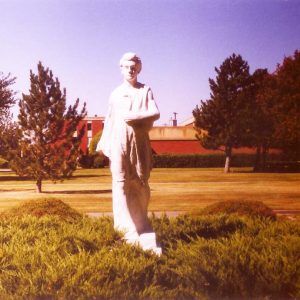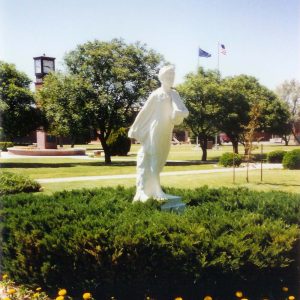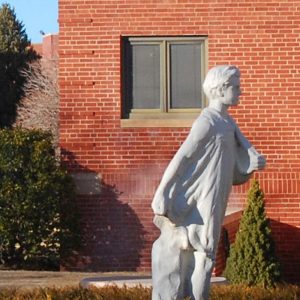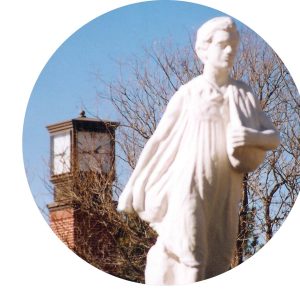The Sower

The Sower is the sole statue on the Oklahoma Panhandle State University (OPSU) campus. It honors the men and women of the High Plains who wrestled with Mother Nature to make their livings from the soil. The artist, Frank Ingels, born in Seward County, Nebraska, on January 2, 1886, had relatives in Texas County—the Gum family. Ingels attended Northwestern Teachers College from 1904 through 1909. While attending college, Ingels met Professor Lorado Taft from the Art Institute of Chicago. Ingels impressed Taft with two busts that he had sculpted of the Northwestern Teachers College’s president and his wife. For ten years, Ingels worked in Taft’s studio in Chicago, and he designed and created The Sower there. His Fountain of Time may still be seen on display in Chicago. Known also for his painting and his architectural designs, he had prestigious showings of his work throughout the nation. He died in Los Angeles, California, on April 26, 1957.
Panhandle Agricultural Institute (PAI) enters the picture when President S. W. “Daddy” Black learned of Ingels’ talents and family connections to the Oklahoma Panhandle through an on-campus guest lecturer: Beaver County school superintendent, Professor Fellow. Black felt a need for “something of a nature that would inspire our young folks.” As a result, Black sent a letter to Ingels in 1915 asking him to contribute something to campus: “No one would be prouder to have one of your products at our school.” Black intended to dedicate the four campus buildings in May 1915 and hoped that a “specimen [by Ingels would be]…unveiled at the same time.” Ingels agreed to design a statue that would pay tribute to the “people of this part of Oklahoma [who] have had to lay the foundation of their homes here in this semi-arid west.” Ingels made The Sower a gift to PAI, for President Black told Mr. Ingels that to raise the money to pay for the talent and labor “would be an absolute impossibility.”
A large assemblage of interested witnesses came to view the unveiling of The Sower on July 3, 1915. The debut of The Sower was impressive, for “no educational institution in the state had a more splendid work of art at that time.” Mary Lee Stewart, young daughter of PAI faculty member L. F. Stewart, pulled the cord to drop the drape to reveal the statue for the first time. The original location of The Sower was east of Hesper Hall and south of where Earle Hall once stood. Since 1915, the statue has been photographed time and again, dressed as Santa Claus for Christmas, painted to support Aggie athletic teams, bedecked with stripes and polka dots, and adorned with capes to flutter in the spring winds.




